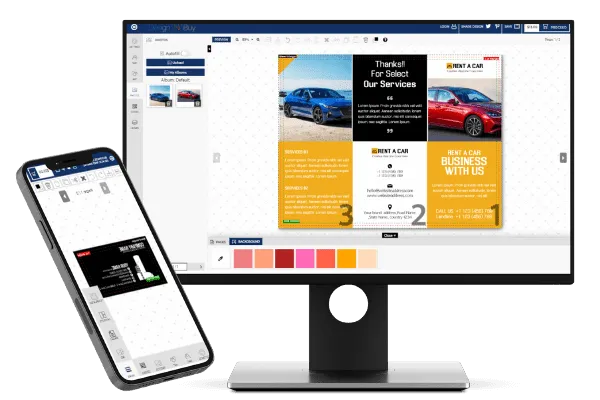If you are dreaming about quitting your 9-to-5 and using your creative instincts to be your boss, you are not the only one.
Many people are using the extended time at home following the COVID-19 pandemic to set up a home business and offer customized products to buyers worldwide.
Of course, it does not hurt if you have similar ambitions. Similarly, if you run an established printing business but want to give it a much-deserved facelift, read on!
The printing industry is a great space to be in as an entrepreneur, as the costs of starting up are relatively low, and the demand for print products such as t-shirts, mugs, wall art and backpacks is heavily on the uptick.
If you are keen on giving your printing business that competitive edge, this quick guide will help you get started at the earliest:
1. Invest small in your printing equipment
It is essential not just to buy the most expensive equipment right away. This is because you are new to the business, and you are looking to test the waters and verify that this something you can do long-term.
Instead, invest in a few affordable pieces of equipment that will get the job done and upgrade once your customer base is expanding, and you are ready to take things to the next level. For instance, sort out a professional-grade laser and inlet printer.
If you are established, slowly branch out from the smaller machinery to large format printers for posters and banners. If you are keen to print on t-shirts and other fabrics, purchase a garment printer.
2. Associate yourself with the right vendors
No printing business cannot run without helpful vendors who will provide you with the type of print products you are looking to sell.
If you want to add more suppliers to the mix, speak to a dozen of them and vet them thoroughly. Evaluate them on pricing, quality, and variety and ask whether they can provide order fulfilment with product printing.
An excellent way to collaborate efficiently with your vendors is through a print shop software solution that equips them with a separate dashboard. This makes it easy for them to simultaneously track multiple order statuses and stay on top of open orders.
3. Streamline your operational workflow

Logistics is a critical aspect of running an online printing business. You are most likely to find it challenging to do the order fulfilment yourself. Therefore, connect with third-party logistics providers for help. You can even take the drop-shipping route.
For instance, once a customer purchases from you, the drop-shipping partner gets an alert to process the end-product and ship it to the customer. You can streamline the entire process on any web-to-print solutions.
That way, you can assure your sales, printing, and logistics teams are well aware of each order’s status and can operate at maximum efficiency.
4. Set up a robust web-to-print store

Since you are selling online, you must build a quality website with the necessary SEO tweaks. Ideally, any web-to-print solutions will come with a personalized branded storefront, a seamless ordering process for your clients, and a variety of print-ready templates.
You also need to check the solution for other capabilities such as pre-designed templates offered in the product design tool, payment gateway options, promptness of user support, and shipping integration. Since there are many options in the market, it is best to research.
5. Invest in short-run printing
Often, customers want limited quantities of a product that you can only afford to sell in bulk, which results in you losing out on their order. To cater to more of these small jobs, try to locate a nearby supplier who can give you the paper, fabric and other print surfaces you need in smaller quantities. This will enable you to do the job without losing money and cater to more customers — thus reducing unnecessary print wastage.
6. Offer a unique type of material
Apart from having distinctive designs that attract your customers’ attention, an excellent way to stand out from the competition is by having a speciality fabric, paper or any material — depending on what you sell — that looks good and is durable enough to handle all your high-quality print orders.
Some varieties in the paper, for instance, you can invest in, including synthetic or waterproof paper for sturdy field manuals, carbonless laser paper for business invoices and receipts, and ‘fold-and-go substrates for corporate gifting and packaging.
Check it out: Matthew Parker To Printers: “Communicate From The Customer’s View Point”
7. Market your business and run promotions

Source: The CMO Survey
Invest time in marketing your print business so that everyone knows about the excellent services you offer. Start social media channels to share promotional content on, and build an email list whom you can inform personally about your discounts, new products and so on.
You should also ask your friends and family to put the word out about you — personal recommendations are highly likely to lead to new purchases!
Promotional deals are inherently attractive to customers looking for quality products at low prices. Run promotions that add value to your customers, such as a free consultation over call, shipping fees waived and a limited-period 30% discount.
You can also have special offers for repeat or high-value customers, such as a guaranteed 50% off on the next five orders on your online design tool.
8. Approach other businesses for orders

Businesses are likely to place much larger orders than individual customers, so be sure to make the most of any corporate networking opportunities you get.
Approach companies of different sizes and offer them products they are likely to need, such as fliers, brochures, corporate gifts or branded t-shirts.
Be sure to do your research on each prospective client to tailor what you are pitching to their individual needs.
For instance, if a restaurant is about to launch its new summertime menu, you can offer to design promotional flyers and attractive new menu cards.
Like you, your corporate clients are also looking to win over their customers by offering unique services. One way for you to help your clients make an impact while also promoting your own print business is by doing direct mail for them.
A personalized envelope and letter along with an attractive gift like a stationery kit or custom footwear can impress customers and motivate them to buy from the business.
In turn, the business will be ready to approach you for more print orders and refer you to other companies that need similar services.
9. Get investors to pitch in
When it is time to expand your print services, you may not necessarily wish to pay for a new set of equipment yourself. It may be a good idea at that time to ask someone to invest in your business for a share of the profits later. You can even approach a friend or family member if you do not want to work with professional investors or start-up incubators.
Become a one-stop-shop
Starting your own print business does not have to be complicated. Follow the steps above — keep an eye out for popular design trends and make sure that your customers always get what they pay for.
Also, take technology very seriously. Invest in a web-to-print solution or upgrade the software so that you can manage your staff, vendors and customers correctly and efficiently. With the right approach and support, you are well on your way to success as an entrepreneur and owning a brand you are proud of.
Researching web-to-print solutions for your business? Book a custom demo here. Do you have another strategy to add to this list? Leave your suggestions in the comments below.




